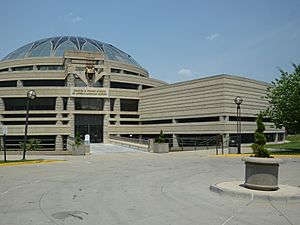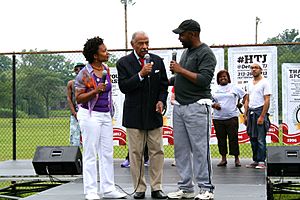History of African Americans in Detroit facts for kids
African Americans in Detroit have a long and important history. In 2017, about 79% of Detroit's population, or over 532,000 people, were Black or African American. This makes Detroit one of the U.S. cities with the highest percentage of Black residents. Many Black families also live in nearby suburbs like Southfield and Pontiac. This large population is due to a big movement of people called the Great Migration, which happened in the early 1900s. People moved to Detroit for jobs in factories.

Contents
History of African American Settlement in Detroit
Early Days Before 1865
Before slavery ended in the U.S., Detroit was a key stop on the Underground Railroad. This was a secret network that helped enslaved people escape to freedom. Because Canada had already ended slavery, many people sought safety there, just across the river from Detroit. Others decided to settle in Detroit itself.
Many local Black residents helped with the Underground Railroad. Important figures included Samuel C. Watson and George DeBaptiste. Many African Americans from Detroit also fought in the American Civil War (1861-1865). The 102nd Regiment United States Colored Troops had many soldiers from Detroit.
During this time, there were growing tensions between Black and white residents. A newspaper, The Detroit Free Press, often printed articles that caused problems. In March 1863, a riot broke out in Detroit. A white crowd attacked Black residents and their homes. This event led to the city creating its first full-time police force.
Growth After the Civil War (1865-1929)
After the Civil War, African Americans became an important political group in Detroit. Leaders like Samuel C. Watson and George DeBaptiste helped guide the community.
Before World War I, Detroit had about 4,000 Black residents. This was only about 1% of the city's population. In the 1890s, journalist Robert Pelham Jr. and lawyer D. Augustus Straker worked to support Black people in legal issues. They helped create local groups of the National Afro-American League.
The Black population in Detroit grew a lot between 1910 and 1930. This was during a time when the auto industry was booming. Many African Americans moved from the Southern U.S. during the first Great Migration. They were looking for better jobs and a chance to escape unfair laws in the South.
By 1930, Detroit's Black population had grown from under 6,000 to over 120,000. The city became the fourth largest in the country. Most Black residents who moved to Michigan during this time came from the South. As more people arrived, housing became a problem. Landlords often limited where Black families could live. This led to crowded areas, and the first clear racial divisions in housing started to appear.
In 1912, the National Association for the Advancement of Colored People (NAACP) started a chapter in Detroit. The Detroit Urban League was founded in 1916. Both groups worked to improve life for Black residents.
Around the 1920s and 1930s, Black workers at Henry Ford's factories often settled in Inkster. This was because they couldn't live in Dearborn and didn't want to travel far from Detroit. White residents often resisted Black families moving into their neighborhoods, even if they were middle-class.
Detroit's Black Community from 1930 to Today
During the Great Depression, fewer people moved to Detroit. But when the U.S. entered World War II, many young men joined the military. This created a big need for workers in factories. A new wave of Black people moved from the South in the Second Great Migration. President Franklin D. Roosevelt made a rule to stop discrimination in defense jobs. This opened up more opportunities for minorities.
Housing Challenges
The large increase in population created tension over jobs and housing. There weren't enough good homes for African Americans. This led to unfair situations in politics and the economy. The government tried to help by building housing projects. But white residents often didn't want these projects in their neighborhoods.
As a result, Black families were often forced to live in poor areas. These areas became very crowded and had difficult living conditions. One such area was known as "Black Bottom." Federal housing rules made it harder for African Americans to get good housing. This also made it harder for them to build wealth over time.
Redlining and Segregation
One way housing was unfair was through something called "redlining." In the 1930s, government agencies made maps to decide which neighborhoods were risky for loans. Areas with many minority groups were often marked in red, meaning they were "high risk." This meant people in these areas couldn't get loans to buy or fix homes. This made it very hard for Black families to improve their living situations or move to better areas.
Restrictive Covenants
Another problem was "racially restrictive covenants." These were legal agreements that said African Americans could not live in certain areas. By 1940, 80% of homes in Detroit had these rules. This forced Black families into specific, often poorer, neighborhoods. The Michigan Supreme Court even said these rules were legal.
Public Housing Efforts
The government tried to help with housing through the Wagner-Steagall Act. This act gave money to local public housing groups. But many people opposed public housing projects. Suburban governments and white community groups didn't want them. Real estate developers also didn't like them because they saw them as competition. Even some elected officials, like Mayor Albert Cobo, spoke out against building public housing in white neighborhoods.
However, some groups, like the Citizens Housing and Planning Council, worked to improve housing. They wanted to replace poor living conditions with better homes for African Americans.
Slum Removal and Displacement
Later, the Detroit City Planning Commission decided to tear down these disadvantaged Black neighborhoods, calling them "slums." They said this was to improve the city, build highways, and new buildings. But the city didn't provide enough help for the Black families whose homes were destroyed. This forced many displaced African Americans into already crowded neighborhoods. This destruction of communities also led to a loss of Black culture and traditions.
Homeowner Associations and Resistance
After racial covenants were banned, homeowner associations took over. These groups in white neighborhoods worked to prevent Black families from moving in. They used legal agreements and worked with real estate brokers to make sure homes were only sold to white individuals.
These associations also worked with Mayor Albert Cobo. They helped shape city policies that kept neighborhoods separated. This meant that even after laws changed, housing segregation continued in Detroit.
Predatory Lending Practices
In 1968, the HUD Act was passed to help with housing. It promised to build many new homes and said the government would pay for foreclosed homes. This led some real estate companies to sell homes at very high prices to poor Black families. They knew these families might struggle to make payments. When families couldn't pay, the companies would take back the homes and get money from the government. Then they would sell the homes again, creating a cycle of unfairness.
The 1943 Riot
Tensions over jobs and housing led to the race riots of 1943. This riot started with a fight among young men and quickly spread. While some blamed Black residents, studies showed that many armed white men attacked Black areas. Black residents who were arrested were often older men defending their homes. The riot ended when 6,000 U.S. Army soldiers stepped in.
Civil Rights Movement and Changes
The Civil Rights Movement in the South also affected Detroit. Activists pushed for more Black representation in local government and the police force. They also fought for equal rights in housing and jobs. In 1965, the Charles H. Wright Museum of African American History was founded, showing the community's pride.
From 1950 to 1970, racial separation in Detroit increased. Many white families moved to new suburbs. This led to more social tensions. Black residents felt unfair treatment from the police and limited housing options. These feelings exploded in the Detroit riot of 1967, which was one of the worst in U.S. history. After this, many middle-class white and Black families began to leave Detroit.
Auto Industry Changes and Population Shifts
Changes in the auto industry caused many job losses in Detroit. This added to the city's problems. The overall population in the Detroit area declined. Many people moved away to find work. Detroit faced concentrated poverty in some areas, and the quality of schools declined.
By 1970, Detroit and six nearby towns had higher than average Black populations. But by 2000, Black people were moving to more suburbs. From 1990 to 2000, almost half of the suburban population growth was from Black people moving there. The Black population in Southfield grew by over 20,000 people in that decade.
At the same time, the total number of Black people in Detroit decreased for the first time. However, because other groups also left, Black people made up a higher percentage of the city's population. By 2010, Southfield was 70% Black. The Black population in Warren also grew a lot.
The Great Recession also affected housing. Some Black families could move into areas that were once too expensive. This led to more mixed neighborhoods.
Important Organizations and Media
- The NAACP has a Detroit chapter.
- The Michigan Chronicle and The Michigan FrontPage are newspapers that serve the African American community.
Recreation and Culture

A Buffalo Soldiers museum is located in western Detroit. It teaches about the history of African American soldiers.
Politics
In the 2020 United States presidential election in Michigan, African Americans in Detroit played a big role in helping Joe Biden win the state. They also helped Gary Peters win the 2020 United States Senate election in Michigan.
Notable People from Detroit
Many important people have come from Detroit's African American community, including several mayors:
- Dennis Archer (Mayor of Detroit)
- Dave Bing (Mayor of Detroit)
- James Boggs (activist)
- John Conyers (Congressman)
- Kwame Kilpatrick (Mayor of Detroit)
- Ossian Sweet (doctor)
- Coleman Young (Mayor of Detroit)

